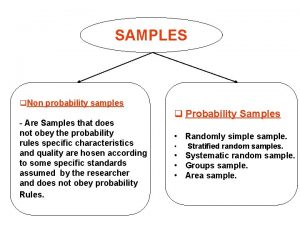Types of Samples Samples Population the main group










- Slides: 10

Types of Samples

Samples • Population – the main group or set from which observations or opinions can be made • Sample – a small part of a population from which data is collected Example: if we collect data from three random students about Mr. K’s class, those three students would be the sample of the population (Mr. K’s class)

Sampling Plans • A sampling plan is a strategy for choosing a sample from a population. • What sampling plan would be good to find out the opinions of students regarding the food in the cafeteria?

Choosing a Sample • When choosing a sample, it should be representative of the population. This means the sample must have characteristics similar to those of the populations. Not all samples are representative samples.

Types of Samples 4 types of sampling strategies: – Convenience sampling – Systematic sampling – Voluntary-response sampling – Random sampling

Convenience Sampling • A convenience sample is made up of people that are easy to reach • Problem: Conclusions drawn may be one sided due to “convenience” of the people in survey. • Example: Surveying people in a library down the street about how many hours a day they read.

Systematic Sampling • In systematic sampling, a list is created of every member in a population. From the list, a certain number of individuals are selected from the beginning of the list and then the person conducting the survey chooses every nth person on the list thereafter to participate. • For example, I can have a list of 1000 people. I will survey the first 50 people and then I will only select every 50 th person thereafter.

Voluntary Sampling • A voluntary sample is made up of people who self-select, or volunteer, into a survey. Often, these people have a strong interest in the topic of the survey • Problem: most volunteers are biased

Random Sampling • Random Sampling involves sampling a population in which every possible participant has the same probability of being chosen. Choosing participants randomly where everyone has the same chance of being picked. • Example: If I put all your names in a hat to choose from, you all have the same chance of being picked. This is an example of random sampling.

Homework • Page 45, #1 -4 • Page 46, #5 -9 • Page 50, #23 a
 Chapter 4 population ecology answer key
Chapter 4 population ecology answer key Population ecology section 1 population dynamics
Population ecology section 1 population dynamics Population ecology section 1 population dynamics
Population ecology section 1 population dynamics Chapter 4 population dynamics study guide answers
Chapter 4 population dynamics study guide answers Types of water sample
Types of water sample Describe the three main properties of a population
Describe the three main properties of a population Present expressing future
Present expressing future Whats a supporting idea
Whats a supporting idea Void main int main
Void main int main Hình ảnh bộ gõ cơ thể búng tay
Hình ảnh bộ gõ cơ thể búng tay Slidetodoc
Slidetodoc



















